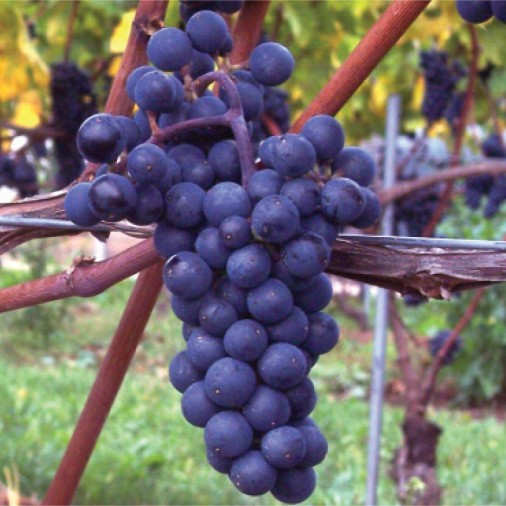
Marquette
Marquette is rapidly becoming the most popular northern red grape variety. Typically maturing with high sugar content and moderate acidity, Marquette can produce complex wines with attractive ruby color and pronounced tannins, often with notes of cherry, berry , black pepper, and spice. If you like pinot noir then you will like Marquette Grapes.
Marquette is the North American cousin to pinot noir. It’s also the most common varietal in Wisconsin and the upper Midwest. Because of its genetic similarities, the expressions are similar, too. It has fruity tasting notes and is similar in body and weight, but, again, the Marquette is more acidic than pinot noir. This is the newest cold climate grape with more characteristics of a Vitis vinifera than other cold climate grapes. It has pinot noir in its ancestry. It has hints of black current, pepper, and plum making a medium-bodied table wine.
Marquette (named for 17th Century Jesuit missionary/explorer Père Marquette) has only been available to the public since 2006, though the original cross responsible for creating it happened in 1989. It was created by Peter Hemstad and James Luby at the University of Minnesota, which has become one of the foremost cold-hardy grape breeding facilities in the United States. The Marquette grape is a complex hybrid grape, which just means that it has more than two different grape species in its lineage. A simple hybrid would be the result of a crossing between two grapes that were of different species and which had no other species in its parentage. Marquette is the direct offspring of Pinot Noir, making Marquette a grandchild of Pinot.
Though Marquette is a very young grape, it is proving popular with growers in cold climate states. The grape is typically made into a dry table wine that is characterized by black fruit and earthy notes with some ‘typical hybrid” aromas and flavors as well. The grape can suffer from high acidity when picked, but malolactic fermentation and barrel ageing can help to keep this in check in the finished wine. Whether Marquette wine will stick around long enough to become a ‘world classic” like Chardonnay or Cabernet Sauvignon is something that only time will tell but it is certainly off to a fast start.
Food matches for Marquette include:
Cheeseburgers, Sausages and mash, Chili con carne, Darker meats, Beef, Venison, and Bison

Frontenac
Developed by the University of Minnesota. It’s a French-American hybrid producing a dry wine of deep garnet color and aroma of cherry and other red fruits. Frontenac can be used in blush wines as well as a fortified wine in the port style. Frontenac produces grapes with high sugar and high acidity used to produce dry red wine, rosé, and port. Wines typically present aromas of cherry and other red fruits. If you like port/dessert wines…It’s sweet and acidic and has tremendous flavor that flavor brings out notes of chocolate, black cherry and other berries. With frontenac, the high acidity works in its favor. What all the winemakers now say, is that frontenac is the king of port style or fortified wines.
Frontenac can withstand cold temperatures and still produce a good quality wine with a pleasant cherry aroma. A consistently heavy producer and vigorous variety with a good resistance to powdery mildew and near-immunity to downy. Ripens mid-season, usually around mid September. Frontenac is a dark-skinned, hybrid French-American grape variety, the result of a crossing made in 1978 between Landot Noir, and a native Vitis riparia vine noted for its resistance to the cold. The crossing was made in 1978 at the University of Minnesota and selected in 1983 when it was tested as MN 1047. It was finally named and released as Frontenac in 1996. It is now the most widely planted red wine grape variety in its home state of Minnesota, and has recently enjoyed some success north of the border in Quebec.
Frontenac’s American parent, known as Vitis riparia #89, was discovered growing wild near Jordan, Minnesota, surviving in winter temperatures that frequently drop as low as -33F (-36C). Trials then got underway to find a suitable partner, to add complexity and depth to an otherwise one-dimensional variety with such cold-hardy qualities. Landot Noir (a cross between Landal Noir 244 and Villard Blanc) was chosen for its late bud-break and early maturity, qualities that made it suitable for short-season sites. Due to high levels of both sugar and acidity, Frontenac wines often need malolactic fermentation to produce a well-balanced wine in cold northern climates. Despite the variety’s blue-black skin color, it has low tannin. It is a cold-hardy variety and extremely resistant to downy mildew, moderately resistant to powdery mildew and not prone to botrytis.
As a wine, Frontenac may be made in dry, sweet or rosé styles and is increasingly used to make port. The juice usually has a deep garnet color, with cherry aromas. Secondary characteristics of blackcurrant, plum and sometimes chocolate have also been identified. Dry styles typically benefit from oak contact.
Food matches for Frontenac include:
Baked Lamb with tomatoes, Chicken with okra and rice stew, Mushroom roulade, Beef, Venison, Bison, and Pasta
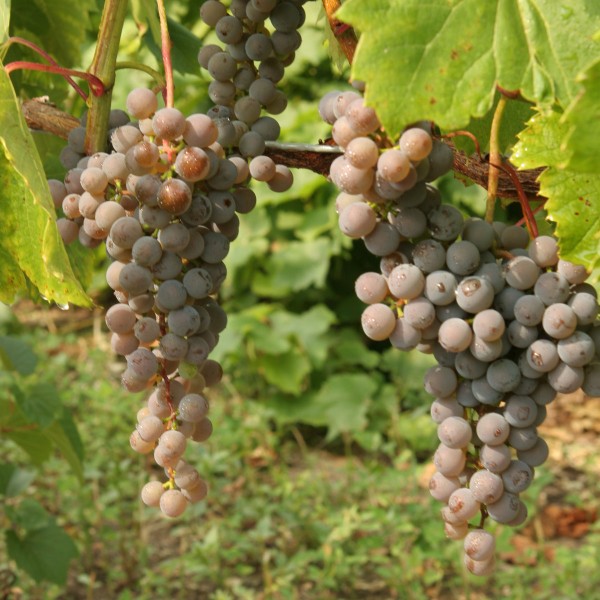
Frontenac Gris
In 1992 a mutation occurred on a Frontenac vine at the Minnesota Horticultural Research Center resulting in grey grapes growing from a single cane. This was later described as Frontenac Gris, a white wine grape, and released to the public in 2003 by the University of Minnesota a mutation of the frontenac grape with muscat-like qualities.
Frontenac gris produces a fruity wine with dominant peach and pineapple flavors. Can also be used to produce semi-sweet, dry, and dessert wines. Frontenac Gris is a bud sport of Frontenac, identical in most respects but lacking dark skin color.
Frontenac Gris is usually cold pressed to make a white wine that can present aromas of peach and apricot with hints of citrus and tropical fruit. Acid gives wine a tart or sour tastes, while dryness is an absence of sweetness. Frontenac gris also does double duty at Cold Country. The varietal is used to make prized ice wine. Frozen grapes are pressed, which results in a higher concentration of sweetness but very little yield of juice. Frontenac Gris is a pink-berried mutation of Frontenac, the cold-hardy hybrid variety bred at the University of Minnesota’s horticultural research center. The University describes the variety as “the white wine version of Frontenac … yielding gray fruit and amber-colored juice”. The variety’s history can be traced back to a single cane on a single Frontenac plant, which began bearing pink-skinned berries instead of black. Such pink-berried mutations are not uncommon in the grape world; other well-known examples include Pinot Gris and Gewurztraminer.
Like Frontenac, Frontenac Gris has strong disease-resistance and is very cold-hardy – essential for surviving the cold, harsh winters experienced in the northern United States (temperatures in Minnesota frequently drop as low as -30F). This, combined with its high yields, makes it a commercially attractive prospect for winegrowers. Due to the pigmentation of their skins, Frontenac Gris grapes make wines with a subtle peach-pink color. The dominant aromas of the wines are those of citrus and tropical fruits, which, combined with its balance of sugars and acids, makes it suitable for the production of both sweet and dry wine styles.
Food matches for Fronenac Gris include:
Chicken and spinach salad with lemon dressing, Main lobster rolls, Wasabi chicken salad, Spicy foods, Italian, Mexica and Cajun foods, and Pizza
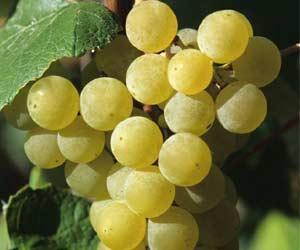
Edelweiss
Edelweiss is an early-ripening, interspecific crossing developed by grape breeder Elmer Swenson at the University of Minnesota in 1980. The variety was made by crossing Ontario and Minnesota 78, two hybrids also developed in Minnesota. Edelweiss was initially envisioned as a table grape, but experimentation with early harvesting revealed its suitability for making white wine. If left on the vine too long, however, Edelweiss’ Vitis labrusca qualities become too intense, resulting in an undesirable foxy taste.
Edelweiss is a very winter-hardy wine grape variety, pale green in color, derived from crossing the Minnesota 78 and Ontario grapes. It was developed by Elmer Swenson in 1980 in cooperation with the University of Minnesota. The clusters are large and rather loose, weighing a pound or more. Developed as a table grape, Edelweiss has medium-sized berries on large loose clusters. Wine is usually finished sweet and has pineapple overtones; fruit should be harvested at 14°- 16° brix to avoid strong Labrusca flavors.
Edelweiss has large clusters, suitable for table grapes, juice and jellies. The variety, like most hybrids, has enviable disease resistance. It can also tolerate extreme cold. It makes an excellent Ice wine.
Food matches with Edelweiss include:
Roast turkey with white wine gravy, Chicken kiev, Seared scallops with butter sauce, and all Desserts

Marechal Foch
Marechal Foch, named after a famous French general marshal Ferdinand Foch played an important role in the negotiation of the armistice terms during the closing of the First World War. It was developed in Alsace, France, by grape hybridizer Eugene Kuhlmann. It has proven to be a worthwhile red grape variety for many colder regions of the world. Technically identified as the Kuhlmann 188, the variety was developed in France during the latter part of the twentieth century. He crossed a riparia-rupestris hybrid and the vinifera variety Goldriesling — Riesling x Courtiller Musque, which was an early-maturing Muscat — and the Marechal Foch was created.
At the time, Marechal Foch was planted on phylloxera-free rootstock in regions that experienced cold winter weather. The variety became a prolific producer and continues with that reputation today. Likened by many to the primary Burgundian red grape (Pinot Noir), Marechal Foch enjoys many positive attributes. Marechal Foch can withstand freezing temperatures, below 32° F (0° C), for extended periods of time. The variety was planted extensively in France during the latter part of the 1800s right through the latter part of the twentieth century, until the French government mandated that hybrid, non-noble varieties be removed. Marechal Foch is a popular hybrid grape variety widespread throughout the Midwestern United States and in Canada. It is cold hardy and disease resistant and happily manages to avoid the “foxy” character that is prevalent in many American hybrids. Instead, Marechal Foch makes a deeply colored wine with earthy characters as well as some jammy, dark-fruit flavors.
Marechal Foch: Called the earliest maturing, cold climate red wine grape grown in the Midwest, a French variety. It’s a versatile grape, which can produce a light Beaujolais style wine. Older vines are capable of producing a dry red, oaked wine capable of aging. It is also used in fortified dessert wines. Maréchal Foch is an early ripening black grape with small berries and clusters, often susceptible to bird predation. It can be made into a variety of wines ranging from light and fruity to full-bodied. Vines are hardy with medium vigor and production. Can be made into a variety of wines from a light red similar to Beaujolais, to a more extracted wine with black fruit flavor, to a sweet, fortified, port style wine.
Marechal Foch is classified as a teinturier, a kind of red grape variety where both the skin and flesh of the grape is a deep red color. This makes for deeply colored wines, and Marechal Foch is often employed in blends to enhance color. This intensity translates to the body of the wine: Marechal Foch makes a weighty wine that is often aged in oak. Enthusiasts often compare aged Marechal Foch with red Burgundy, but the variety is probably more akin to a spicy Beaujolais.
Food matches for Marechal Foch include:
Tuna nicoise, Jambalaya, Roasted beetroot and broccoli salad, Darker meats, Beef, Venison, Bison, and Grilled foods
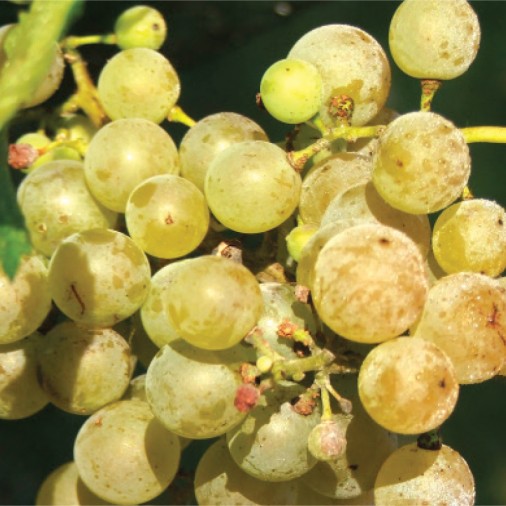
Vignoles
Vignoles is a light-skinned hybrid grape variety first bred in France, but now grown mainly in the Finger Lakes AVA in New York State, as well as in a handful of other midwestern U.S. states. Wines made from the versatile variety range from dry to very sweet, and display honeyed notes of pineapple, apricot and citrus fruits. The variety was first bred in Saone-et-Loire in the 1930s by grape breeder J. Ravat, and is thought to have either Pinot Noir or Chardonnay in its parentage, along with one of the hybrid Siebel varieties.
Vignoles, as the variety is most commonly known, is well suited to cold continental climates, as late budding and early ripening helps it to avoid frost risk. It is moderately cold hardy, and the small, thick-skinned grapes are highly susceptible to botrytis, the noble rot responsible for some of the world’s great sweet wines such as Tokaji and Sauternes. High acidity and sugar levels make Vignoles a good choice for vintners looking to make dessert wines, and if the region is cold enough, ice wine can be produced from frozen grapes.
Food matches for Ravat Vignoles include:
Spicy Vietnamese pho (off-dry), Ham with fruit chutney (off-dry), Lemon pound cake (sweet), Appetizers, Cheese and crackers, Snacks, and Salads
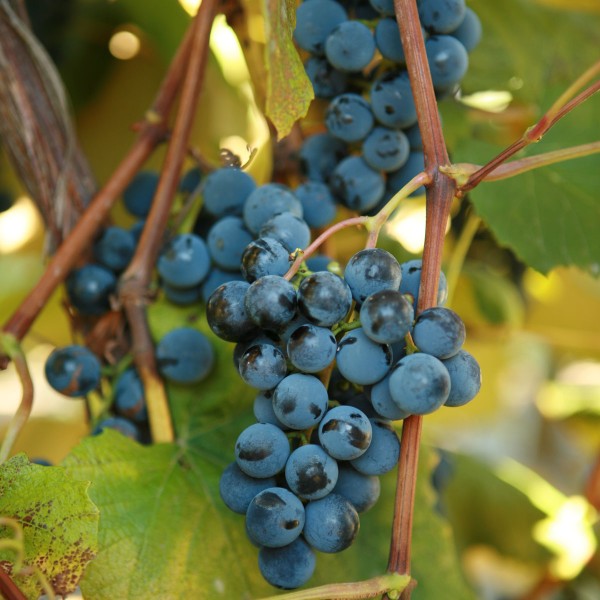
Concord
Concord is at the core of the United States‘ wine history and culture. Prior to the rise of Californian wine to mainstream prominence in the 1980s, Concord helped introduce many Americans to wine. It is a labrusca-dominant variety, also thought to have inherited many of its genes from native grapes. True to its heritage, Concord displays many labrusca-like characteristics, such as cold-resistance, distinctive foxy and nail-varnish aromas and candied strawberry flavors. Concord is named after the town in Massachusetts where it was introduced from a wild vine cutting in 1843.
Concord is extremely popular in New York State, where its fruit may be used in the production of sweet, often kosher, wine, and various non-alcoholic grape juices and jellies. At harvest time, it is sometimes used to make grape pie. In the vineyard, it is a small vine with low crops, but planted in such great quantity that underproduction is seldom an issue.
Concord’s offspring is the Niagara grape. Concord is the most famous American grape, described by Horace Greeley as “the grape for the millions” with vigorous, hardy and productive vines that produce medium-sized clusters bearing large blue-black berries. Concord grapes are tough skinned, flavorful and highly aromatic – an all purpose grape used to make grape jelly, juice, and grape flavored soft drinks.
Food matches for Concord include:
Mortadella sausage, Deep dish pizza, and Meatloaf with mashed potatoes
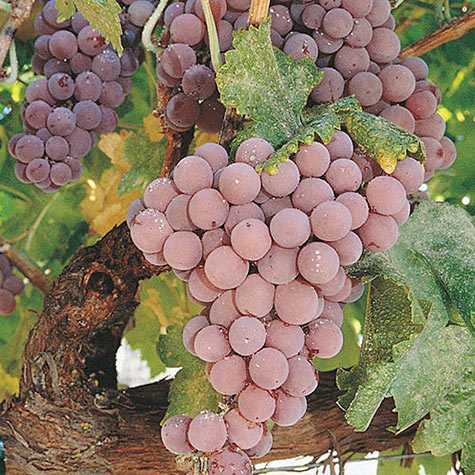
Reliance
The Purple Reliance Seedless grapevine is marketed as an after dinner, dessert grape item that usually ripens in July, and this Grape Vine consistently produces a crop of sweet, firm to the touch, purple grapes that have a long shelf life. The Reliance Grape Vine is considered to be a very reliable seedless grape vine that continually produces a dependable high quality grape crop.
The Purple, Reliance Seedless Grapes mature in a wide array of colors through which they pass before becoming that identifiable, beautiful purple color, a point at which they are ready to eat. Reliance produces large clusters of round, red, medium-sized berries with tender skin non-adhering to flesh. Color is pink to red when fully mature with delicate Labrusca flavor and aroma, without noticeable seed traces. Reliance is the seedless grape with large, firm rosy-colored seedless fruit and very cold-hardy vines. It’s great for fresh-eating, jams, jellies and desserts.
Choose a spot in the garden with good drainage in full sun. Produces a consistent crop of large sweet firm red grapes. Hardiest of the seedless grapes. Sugar-sweet, rosy fruit is big and plump, perfect for snacking. Cold-hardy vines take sub-zero temperatures. Ripens in late August; produces 40-50 clusters per vine. Highly disease resistant. Large, well-filled clusters. Fruit has a tender skin and flesh with melting texture. Fruit has an outstanding, mild fruity flavor with high sugar content. Vigorous, productive, dependable vine. Somewhat susceptible for black rot. Stores up to 3 months. Resists anthracnose and mildews.